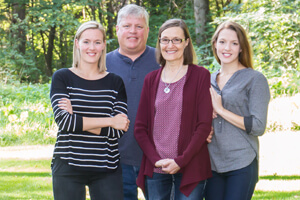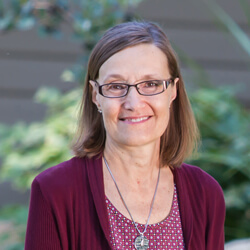Brain Cancer: Pam
Cancer Care“Just like that, the day came that I had to show up for my first radiation treatment — it was a bad day. Sandy Johnson, RN, CNS, was my advocate. She already knew my emotions and what I was feeling. When you walk into the waiting room, you look around and really realize, ‘Oh my God, I have cancer. Look at all these people who have cancer too.’”
A New Chapter
At age 47, Pam Schnettler was preparing for her oldest daughter’s graduation party during Memorial weekend 2008. Through the hustle and bustle of her long to-do list, things suddenly took an unexpected turn. During a trip to the supermarket, Pam suddenly felt the grocery aisles caving in. She went home to rest, which is the last thing she remembers that day. After being awakened by her family and being in and out of consciousness, they called 911 and an ambulance arrived soon after, at their home in Sartell.
After awakening in the Emergency Room, the physician and Pam’s husband, Greg, told her she had a brain tumor. She then had a brain biopsy and MRI, which showed it was cancer. After discussing her options with Harold Windschitl, MD, and Hani Alkhatib, MD, the final decision was made to not have surgery. Knowing the large size of her tumor, they stated that the surgery would not remove it all, and could result in deficits including loss of peripheral vision and a potential weakness on one side of her body. Knowing the importance of quality of life for Pam, this was the best choice.
All of this happened at a very significant time in Pam’s life — her first daughter’s graduation, getting her moved and settled into college and saying goodbye. 
Thankfully, her family and friends stepped up to the plate not only to help her with the graduation party, but all the emotions brought on by these new transitions of life. Pam’s friends and family were a strong support network — from keeping her busy making a T-shirt quilt for her daughters, to planning fun visits and dinners to just check in. The overwhelming amount of prayers also were comforting.
In July 2008, Pam started radiation therapy. “Just like that, the day came that I had to show up for my first radiation treatment — it was a bad day. Sandy Johnson, RN, CNS, was my advocate. She already knew my emotions and what I was feeling. When you walk into the waiting room, you look around and really realize, ‘Oh my God, I have cancer. Look at all these people who have cancer too.’ Sandy came out and put me at ease. She made the conversation light and I was grateful for her at that painful moment. The radiation staff were absolutely a great group of people. I saw them for six weeks. They were so friendly, supportive and timely with results and updates. I was really happy with all of that,” Pam said.
Pam responded well to the treatments, and did not have a reoccurrence until April 2014. At this point, she saw Neurologist Kathleen Rieke, MD. “She was very supportive and extremely knowledgeable. Viewing MRI results with Dr. Rieke helped me see changes in the tumor,” she said. Pam felt Don Jurgens, MD, her medical oncologist, did an extraordinary job at compromising and dealing with her strong-willed personality. He explained how Pam’s type of brain tumor, oligodendroglioma, is rare and only found in 9.4 percent of brain cancers. He clarified that because her tumor was very slow growing, her clinical symptoms outweighed her MRI results, which put her at ease. Chemotherapy was the next option. After chemotherapy, Pam’s MRI was positive and showed if anything was left, it was small. Her job going forward was to keep her immune system in tip-top shape by eating healthy and exercising.
Meditation and prayer both played a significant role in her healing process. Pam feels a connection to Mother Teresa and reflects on her life often since one of the miracles which qualified her for Sainthood was curing a person with a cancerous tumor.
Pam learned many lessons along her cancer journey, but the three most important were: Number one, “Anyone overwhelmed by illness — pick that one person. That one person that’s a good listener, has a good memory and can absorb the information for you. My greatest support was my husband, Greg. He reminded me when to eat, take my medications and when I didn’t remember something, I knew I could rely on him.”
Number two, “Make sure you have a primary care provider. I was very healthy and did not have one. When I first left the hospital, I didn’t have an advocate for me, or someone who knew me well in the medical field, which made it much more challenging.”
And Number three, “Diversions are a must throughout this challenging time. My daughters were my number one diversion. They have been a great support, especially in a way that I still need to be a mom to them. I try to be as healthy and vibrant as I can so my daughters and family, although concerned, feel much better. Not only am I a cancer patient, but also a caregiver to my loved ones around me when it comes down to their emotions and ability to have hope for me. Diversions are important to make life as normal as possible.”
Pam feels grateful to have a job that she loves surrounded by wonderful coworkers and friends. As an accounting specialist for CentraCare Health, she said, “I love what I do — it keeps my quality of life amazing. I still look forward to coming to the office. I work as much as I can because it leaves less time to dwell on cancer. I feel good when I am here because it keeps my mind occupied and I need to exercise my brain.”
This challenging journey has been a life lesson for Pam. It has taught her how to be more supportive and a better friend to others that also may be struggling in life. From this experience, she feels very fortunate and realizes how important a good life is to healing and health … and perhaps even a complete cure.
